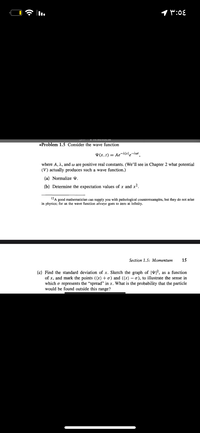Question

Transcribed Image Text:1 W:0E
I VIO.Iau.cuu.3a
*Problem 1.5 Consider the wave function
¥ (x, t) = Ae-Alxle-iwt
where A, 2, and w are positive real constants. (We'il see in Chapter 2 what potential
(V) actually produces such a wave function.)
(a) Normalize Y.
(b) Determine the expectation values of x and x2.
12A good mathematician can supply you with pathological counterexamples, but they do not arise
in physics; for us the wave function always goes to zero at infinity.
Section 1.5: Momentum
15
(c) Find the standard deviation of x. Sketch the graph of |4|², as a function
of x, and mark the points ((x)+o) and ((x) – o), to illustrate the sense in
which o represents the "spread" in x. What is the probability that the particle
would be found outside this range?
Expert Solution
This question has been solved!
Explore an expertly crafted, step-by-step solution for a thorough understanding of key concepts.
Step by stepSolved in 2 steps with 1 images

Knowledge Booster
Similar questions
- QUESTION 2 Hermite polynomials are useful for solving for the wave functions of a 3-dimensional harmonic oscillator. O True O Falsearrow_forwardQuestion A3 A wavefunction takes the form = A sin(2x) in the interval -1 < x < 1, and is zero everywhere else. You may take A to be a real-valued constant. a) Calculate the value of the constant A by performing a normalization. b) Calculate the probability of finding this particle in the region 0 < x < 1/16. [8 marks]arrow_forwardOf the boX. 3. Draw and label the potential in the table on the right. Show the Wave Function, Y, expected in each region ofx for: a) a particle with energy, E = 2 eV. b) a particle with energy, E = 4 eV. c) a particle with energy, E = 6 eV. U X +5.00ev 0.00eV X < 0 0arrow_forward
- Assistance with last two questionsarrow_forwardQUESTION 1 The expectation value is the strict average of the possible values. O True Falsearrow_forwardUse your generic solution to the 2D box wavefunctions to demonstrate the following prop- erties of wavefunctions. 1. Show that if you independently normalize (x) and (y) that the product of (x) and (y) is also normalized. 2. Show that the wavefunctions for one dimension are orthogonal. Orthogonality means that f₁ Vndr = Smn, where the Kroenecker delta function means that the function is one for men and zero for m‡n. m 3. How many quantum numbers are needed to describe the energy of your system? 4. Show that the two dimensional wavefunctions are orthogonal by performing this test on the wavefunction for n = 1, ny = 2 and the wavefunction for nr = 2 and ny = 1. CLx Ly Mathematically the operations looks like f¹* f¹¹ V₁,2 (x, y) V2,1 (x, y) dxdy.arrow_forward
- Problem #2 Calculate the Legendre transform (F1) of y = x². For your answer, give the new function F1 and its derivative dF1. (a(f(x)) Note that dy = C dx, C, = f(x), and dC, = (0) dx. dxarrow_forwardPHET Simulation - Wave on a String Submit Previous Answers v Correct The effect of damping is akin to the absorbance or partial reflection of light, whore the amplitude of in phase photons becomes reduced. Part B Reset the PHET simulation (using the button in the lower tight) and set it up in the following manner select Oscillate, select No End, and use the parameters in parentheses by sliding the bars for Amplitude (1.00 cm). Frequency (2.00 Hz). Damping (none), and Tension (highest) Using the available Rulers, calculate the frequency of a photon that corresponds to the wavelength of the resulting wave. Assume the length with umits (cm) of the ruler represents the real photon wavelength and that the spced of light is 3.00 x 10° m/s. Express the frequency in hertz to two significant figures. > View Available Hint(s) ΑΣφ frequency= Hz Submit Part C Complete previous part(s) 452 PM P Type here to search Fi 322021arrow_forwardplease solve number 4arrow_forward
arrow_back_ios
SEE MORE QUESTIONS
arrow_forward_ios